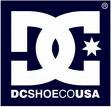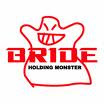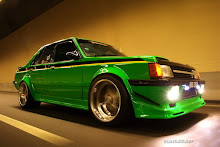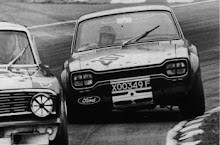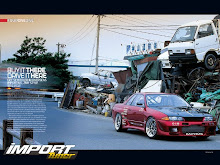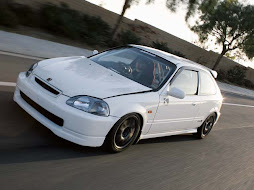
Monday, May 26, 2008
Today we're going to talk a little about drift technique.
For someone who has never been sideways in acar before, the first drift experience isunforgettable. But before you go hit the cornersat full speed and wreck your car, try theseeasy practice techniques.Find a big open place, I recommend a "skid pan"or "skid pad" at your local circuit and have somefun dropping the clutch and spinning the tire.Then, to get some control and be able to directyour car where you want while drifting, put downsome pilons or cones. First, just with 1 singlecone, do donuts around it. Start of going clock-wise, then change and go anti-clockwise. Do smalldonuts and then do bigger onesWhen you've got the donuts down, put one morepilon down and practice doing figure 8's. Thiswill help you get good at drift transitions(changing directions while drifting or "fish-tailing").They are some basic skills you need before yougo flat out and damage your car.
I want to go over some advanced drift
You probably know the names of all the techniques,ie. hand-brake slide, faint, clutch kick, drop-off,overpower. braking drift etc. But which ones are the best to use in which situation?If you're just starting out in drifting, you probablyuse the hand-brake technique mostly. That's fine.It does slow your entry speed down a fair bit though,but that is necessary for some corners. Some beginnersuse the hand-brake too much so be aware.The most popular technique used to get the rear outis the clutch-kick. Clutch kicking is where you jabthe clutch at speed while jerking the steering wheelto get you sideways.However, before you try it on just any corner..... Practice at low speeds first and make sure there is plenty of room because more than likely, you're goingto spin out or go flying off track in a direction you weren't planning to!Once you get better, you can go faster and try biggercorners. Just start out small. Next Advanced Tip.....Line is everything. Sure it's easy to go around acorner sideways but when it comes to linking corners,the line of drift is vital. I was told this when Iwas starting to learn how to drift. "Out, Out, Out, Out, In!" Basically, you stay to the outside of the corner until you are pointing in the direction you want to be in for the next corner. When flicking back, use your foot brake if you are going too fast or even your hand-brake. Have fun using these techniques but take care of yourself and your car :)
Here a few things you must keep in mind ....
...want to buy a drift car or tune your old one.
1.Make sure your drift car is Rear Wheel Drive.
I hope I you know enough about cars to know what
a rwd car is, if you don’t, then I’m not quite sure
drift is the smartest or safest move for you. A
rwd car lets you slide the rear tires out, causing
your car to drift.
2.You need a good power to weight ratio in your
drift car. Most popular drift cars are Japanese
sports cars. A very popular drift car is the AE86
Trueno or Sprinter or “hachiroku” by Toyota.
Other popular drift cars are one’s made by Nissan
like the 240sx (180sx as it’s know in Japan and
Australia), Silvia – S13, S14, S15, Skyline – R32,
R33, R34 both coupes and 4 door sedans. Then there
are the bigger drift cars that are becoming popular
here in Japan like the Toyota Chaser or Mark II.
Mazda’s Rx7 – FC, FD's are also very popular but
a little hard to drift for a beginner.
3.You then need a few essential parts on your car
to make it drift.
Most important is an LSD (limited slip diff). This
allows you to spin both rear tires at the same time,
making it easier to drift.
A bucket seat is next. Makers like Bride and Recaro
have great one’s pro drifters use.
Coil over or lowered suspension is a must have to
lower the center of gravity and stiffen the
suspension of your car. That’s about it for the
main drift parts. If you want to make your car
look like it’s straight from the movie “Fast and
Furious: Tokyo Drift”, the you will need a body
kit, big chrome wheels, neon lights and a big
exhaust etc.
1.Make sure your drift car is Rear Wheel Drive.
I hope I you know enough about cars to know what
a rwd car is, if you don’t, then I’m not quite sure
drift is the smartest or safest move for you. A
rwd car lets you slide the rear tires out, causing
your car to drift.
2.You need a good power to weight ratio in your
drift car. Most popular drift cars are Japanese
sports cars. A very popular drift car is the AE86
Trueno or Sprinter or “hachiroku” by Toyota.
Other popular drift cars are one’s made by Nissan
like the 240sx (180sx as it’s know in Japan and
Australia), Silvia – S13, S14, S15, Skyline – R32,
R33, R34 both coupes and 4 door sedans. Then there
are the bigger drift cars that are becoming popular
here in Japan like the Toyota Chaser or Mark II.
Mazda’s Rx7 – FC, FD's are also very popular but
a little hard to drift for a beginner.
3.You then need a few essential parts on your car
to make it drift.
Most important is an LSD (limited slip diff). This
allows you to spin both rear tires at the same time,
making it easier to drift.
A bucket seat is next. Makers like Bride and Recaro
have great one’s pro drifters use.
Coil over or lowered suspension is a must have to
lower the center of gravity and stiffen the
suspension of your car. That’s about it for the
main drift parts. If you want to make your car
look like it’s straight from the movie “Fast and
Furious: Tokyo Drift”, the you will need a body
kit, big chrome wheels, neon lights and a big
exhaust etc.
Friday, May 23, 2008
Wednesday, May 21, 2008
Monday, May 12, 2008
Friday, May 9, 2008
2008 Honda CB1000R - First Ride
2008 Honda CB100R
Unfortunately, Honda is keeping its new super naked for Europe only, but that doesn't mean our U.S. readers can't see what their missing. Americans are accustomed to hearing some British blokes called the Stones singing "You can't always get what you want," now our pals at MCN give us their rendition with this review on the Honda CB1000R.
By Marc Potter
Pictures by Howard Boylan and Honda
Way back in the '60s, when men had quiffs and woman wore beehives, the Japanese bike manufacturers invaded Europe. Their bikes looked strangely like the ones made in the midlands but they had funny winged logos on the tanks. And they worked come rain or shine.
The copycats were laughed off at first and then makes like Honda, Kawasaki, Yamaha and Suzuki started landing on our shores in big numbers, at the right price, with the right kit (like electric starters that worked) and engines that didn't leak. And they took over the world of motorcycling forever.
It stayed that way for the last 40 years until a small manufacturer in Hinckley started making a bike called the Speed Triple and essentially created the Super Naked bike. Having been the first person in the world to ride the prototype, I remember that moment well. Okay, so the Ducati Monster was the original but that didn't have the same sort of sports bike horsepower linked with quality suspension and brakes, and the kind of style reminiscent of a crashed GSX-R1100 with bug-eye headlamps.
And now the tables have turned again, as the world's biggest bike manufacturer looks down from its ivory tower to a small industrial unit in Leicestershire and decides it's very interested in a bike called the Speed Triple. Combine it with a healthy respect for bikes like the MV Agusta Brutale and the Monster and you're starting to get the measure of Honda's new CB1000R.
Big H won't admit their influences but an off the record chat with a few people confirmed what I just said, and it's not going on sale in Japan because the emissions laws are so strict it would have to have an exhaust the size of a small car. This bike is for Europe only and that's where most of the design work and development was done.
Forget the fact it has the same name as the dinosaur CB1000 of the early nineties, or that it's a spine-framed, FireBlade-engined naked like the now defunct 900 Hornet. This is a whole new bag for Honda. A bike designed with Europe in mind and one that uses a retuned version of the 2007 FireBlade CBR1000RR engine and runs 2008 FireBlade forks, 2008 FireBlade brakes, a beautiful single-sided swingarm and styling tailored to the decor of the very best designer cafes in Milan. In green it looks purposeful, in white it looks as good as anything on the road.
And then there's the bike's heritage. It was developed by Tetsuya Kudoh, the man who was chief engineer and test rider on such bikes as the VFR400, RC30, NR750, CBR600F and VFR750F, so nothing much good in there then. And as such it's one high-spec piece of kit. The single-sided swingarm is one of the things that gives away the fact this isn't your average fat and lazy naked bike.
Then there's the short stubby attitude of the CB100R: the tiny seat unit designed as a token gesture to attract nubile Italian goddess' who may want to perch on your steed, so to speak. (But in reality no real human would want to sit on the back and you'd never get a tail pack on it, but Honda designed it that way.) It's all about being purposeful, minimal, and saying to everyone watching that you're a no compromise kind of guy who likes to ride fast and look good. The CB1000R weighs in wet at 217 kg (478 lbs), which is just 18 kg (40 lbs) more than the super lightweight 2008 Blade and most of that extra weight is in the heavily braced single-sided swingarm.
Check out the swoopy four-spoke rear wheel, the LCD clocks that are claimed to be the most expensive Honda make, the jagged lines of the bodywork and the aggressive 'ready-to-attack' stance, and you can tell this is no normal Japanese naked bike. It's designed to give a sporty ride with the stylish looks of a naked, and it more than delivers.
Undoubtedly it's a serious bit of kit that aims to do a totally different job to the old Hornet 900, and it's a bike that I'm slightly afraid of riding when I get handed the keys in the center of Milan on a wet and slippery Saturday morning.
But fearful is not one of the things that enters your head when you start riding the tiny Honda. Filtering through Milan in convoy behind a mad Welshman intent on showing us his knowledge of Milan's backstreets, the bike is gentle, easy and torquey. The fuelling is perfect, the grunt is huge and I'm already starting to think that for most people, most of the time this engine would be better in a FireBlade than the super-powerful motor de rigeur of bikes that say you're a real man, even if secretly the amount of horsepower terrifies you. Or is that just me?
Drift Tires Explained: Size? High Grip? Air Pressure?
Drift tires are a tricky part of your drift car set up to get right. Get your tire choice and settings wrong and you won't have much fun.
>> Tire Size
When it comes to choosing the right size tire for your drift car, you have to make sure your car is going to have enough power to spin them. Make sure it's not too big in diameter or width because it takes more power to spin them.
17" wheels and tires look cool but if you have them on a non-turbo AE86 sprinter, then you'll find it hard to spin them. I'd go with some 15" tires instead. I actually still use 15" on my Cefiro about 205/55/15 are ideal) and 16"s sometimes. 17" and above are OK for modded turbo cars with low profile tires.
>> High Grip vs. Low Grip
 Again it depends on the car. If it's a high powered turbo car and you are an advanced driver not scared of high speed drifting, then high grip tires are good.
Again it depends on the car. If it's a high powered turbo car and you are an advanced driver not scared of high speed drifting, then high grip tires are good.
Popular high grip tires here in Japan are Yokohama Neova. For beginners, usual normal cheap tires are good for praticing in as they are easier to spin and if you're not going too fast, can stop you if you need. Just make sure they have grip ;)
>> Tire Pressure
Tire pressure depends on the type of tire you're using and your own personal preference. The general rule I follow is for new or near-new tires, you can put more air pressure in them (around 25psi when cold) and they will last a long time and slide nicely.
For old tire that have been sitting or used for a long time, you need to use a little lower air pressure or your tires will de-laminate very quickly. De-laminating is when the tread peels off in one piece piece. If you run around 22psi when cold in your older tires, they won't de-laminate as quickly.
After a few laps of drifting, check your tire pressure and you'll notice they pressure will have increased by about 4-5 psi. If your pressure gets above 35 psi, you should let some air out or you could burst it.
>> Other tips
 Don't keep drifting until your tire bursts. It makes it hard to drive your car back to the pits and jack the car up to change it. You can also damage your car's spoilers etc.
Don't keep drifting until your tire bursts. It makes it hard to drive your car back to the pits and jack the car up to change it. You can also damage your car's spoilers etc.
If you notice one side of your tire wearing faster than the other, you can always rotate them to get more life out to them.
Live fun, Drift safe!
Stu - www.DriftInJapan.com
>> Tire Size
When it comes to choosing the right size tire for your drift car, you have to make sure your car is going to have enough power to spin them. Make sure it's not too big in diameter or width because it takes more power to spin them.
17" wheels and tires look cool but if you have them on a non-turbo AE86 sprinter, then you'll find it hard to spin them. I'd go with some 15" tires instead. I actually still use 15" on my Cefiro about 205/55/15 are ideal) and 16"s sometimes. 17" and above are OK for modded turbo cars with low profile tires.
>> High Grip vs. Low Grip
Popular high grip tires here in Japan are Yokohama Neova. For beginners, usual normal cheap tires are good for praticing in as they are easier to spin and if you're not going too fast, can stop you if you need. Just make sure they have grip ;)
>> Tire Pressure
Tire pressure depends on the type of tire you're using and your own personal preference. The general rule I follow is for new or near-new tires, you can put more air pressure in them (around 25psi when cold) and they will last a long time and slide nicely.
For old tire that have been sitting or used for a long time, you need to use a little lower air pressure or your tires will de-laminate very quickly. De-laminating is when the tread peels off in one piece piece. If you run around 22psi when cold in your older tires, they won't de-laminate as quickly.
After a few laps of drifting, check your tire pressure and you'll notice they pressure will have increased by about 4-5 psi. If your pressure gets above 35 psi, you should let some air out or you could burst it.
>> Other tips
If you notice one side of your tire wearing faster than the other, you can always rotate them to get more life out to them.
Live fun, Drift safe!
Stu - www.DriftInJapan.com
How to Drift: Angle explained
Hey drift fans, it's been a long long time since I updates my blog here at Drift In Japan. But I found some cool illustrations showing drift angles of different types of cars.
Let's have a look shall we...
 FR - Rear wheel drive drifting angle
FR - Rear wheel drive drifting angle
You'll notice with the angle for FR drifting, it starts early and ends later - meaning you're drifting for a longer period of time. If you are thinking you're going to straighten up and need more angle, you can just give your car more gas and you can swing the back out. That's why FR drifting is the most popular because it's the easiest and lasts longest.
 FF - Front wheel drive drifting angle
FF - Front wheel drive drifting angle
With FF cars, the front wheels are doing the driving. The drifting is initialted with the hand brake (e-brake) and starts early but finishes early too. You need to be straightened up and heading straight in the direction you want to go. You can't power the car to get more angle like an FR car.
 AWD - All wheel drive drifting angle
AWD - All wheel drive drifting angle
AWD drifting line is similar to the FF line as the main pulling wheels are the front ones. The angle starts a lot later and finishes early. I've never actually drifted an AWD car, even though I drive a WRX on the street, but from what I hear, they're the most difficult of all types of cars to drift.
NOTE: Tale a look at the line of drift. This line can be applied to all types of corners. You go wide at first and when you hit the apex, you need to be heading in the direction you want to go.
Drift hard, live safe!
Stu from DriftInJapan.com
Let's have a look shall we...
You'll notice with the angle for FR drifting, it starts early and ends later - meaning you're drifting for a longer period of time. If you are thinking you're going to straighten up and need more angle, you can just give your car more gas and you can swing the back out. That's why FR drifting is the most popular because it's the easiest and lasts longest.
With FF cars, the front wheels are doing the driving. The drifting is initialted with the hand brake (e-brake) and starts early but finishes early too. You need to be straightened up and heading straight in the direction you want to go. You can't power the car to get more angle like an FR car.
AWD drifting line is similar to the FF line as the main pulling wheels are the front ones. The angle starts a lot later and finishes early. I've never actually drifted an AWD car, even though I drive a WRX on the street, but from what I hear, they're the most difficult of all types of cars to drift.
NOTE: Tale a look at the line of drift. This line can be applied to all types of corners. You go wide at first and when you hit the apex, you need to be heading in the direction you want to go.
Drift hard, live safe!
Stu from DriftInJapan.com
Labels:
drifting-angle,
drifting-lesson,
drifting-tips,
how-to-drift
How to Import a Car from Japan Yourself
The average Joe drifter doesn't know how to import a car from Japan, so today I want to tell you a little about how to get your favorite Japanese car into your country.
Most people go about importing a Japanese car through an agent or dealer. This is fine, but it can be expensive when unseen expenses arise.
Basically, you give him your "dream" car description to and he goes out to find one by searching the Japanese used car auctions or looks through ones he already has for a car that matches.
He then purchases it on your behalf, puts it on a boat to your country and arranges all the import and customs forms. It arrives and another agent picks it up and arranges the customs clearance and pays import fees/taxes etc.
After that, it's ready to be registered and driven on the street!
You're all happy....untill,
Untill, your jaw drops when you see the bill for the services and then all the 'extra' unseen charges that have added up! You've got your car but not any money left for gasoline to drive the darn thing! But there is a better way to go about importing a car from Japan.
Here's how to do it.... There is a membership website full of expert guidance that will show you the easy way, step-by-step on "how to import a car from Japan by yourself".
The lifetime membership will set you back a little under $40, but when you consider the hundreds, if not thousands of dollars you will save by importing your Japanese car by yourself, it makes sense to get the expert and personal help.
For more information and help about how to import a car from Japan, click here to visit www.ImportaJapCar.com
I highly recommend it for anyone looking to import their very own Japanese performance car without wasting money on an expensive agent.
Happy drifting,
Stuart -www.DriftInJapan.com
Cars of Fast and Furious Tokyo Drift
Lets have a closer look at some of the cars of Fast and Furious Tokyo Drift....
By far the star car of the Fast and Furious Tokyo Drift has to be the FD Mazda Rx7 with the black and orange duco over the Veliside bodykit. I actually know the guy who sold them that FD and I saw the original while it was still a junker :)
The Mafia's bad guy's black Nissan 350Z which everyone gasped as they watched it drift up the spiral driveway in the car park. That stunt was done by NZ/USA drifter Rhys Millen without any CG, he did it all with just the car!
The red Lancer Evo was a head turner too as Evos are generally known as all wheel drive cars that don't really drift. This is the car he practiced and learned to drift in.
Japanese drifting and racing legend Keiichi Tsuchiya made an appearance as a fisherman when the red Evo was practicing at the wharf.
I remember he says "kountaa wa osoi ne" which means "He's too late with his counter steer."
The 'girl' car, sky blue Mazda RX8 appeared an was driven by Australian actress Nathalie Kelley. I love RX8's but not this one. The color and body kit weren't the best suit for it. I guess they were trying to make it girly.
The 1967 Mustang Fastback (as pics above)was thrown in the plot to mix up the cars a bit. We see new Mustangs drift but hardly ever old school classics like this one drift! But this one was a little different. It had a Nissan RB26 powering it instead of the old ford V8 engine.At the time of the movie's release, I asked Kumakubo san (Pro D1 Driver) about the cars of Fast and Furious Tokyo Drift (he was a stunt driver in the movie) and he said the Mustang was the worst car to drift out of all of them. He mentioned the Evo was the best drift car...and that's probably the reason he built his Evo 9 drift car for the Japanese D1 competition.
The Fast and Furious Tokyo Drift is a movie you can switch on and watch anytime. You don't need to follow the story, just watch the cars, girls and drifting. That's more important anyway!
Drift hard, live safe.
Stu - www.DriftinJapan.com
Monday, May 5, 2008
Mazda Premacy Hybrid
The Mazda Premacy (known to the U.S. as the Mazda5) Hydrogen RE Hybrid is equipped with a transverse-mounted hydrogen rotary engine that converts energy from hydrogen combustion into electricity. Mazda plans to begin leasing the vehicle to select customers sometime in 2008.
Sunday, May 4, 2008
Subscribe to:
Posts (Atom)










